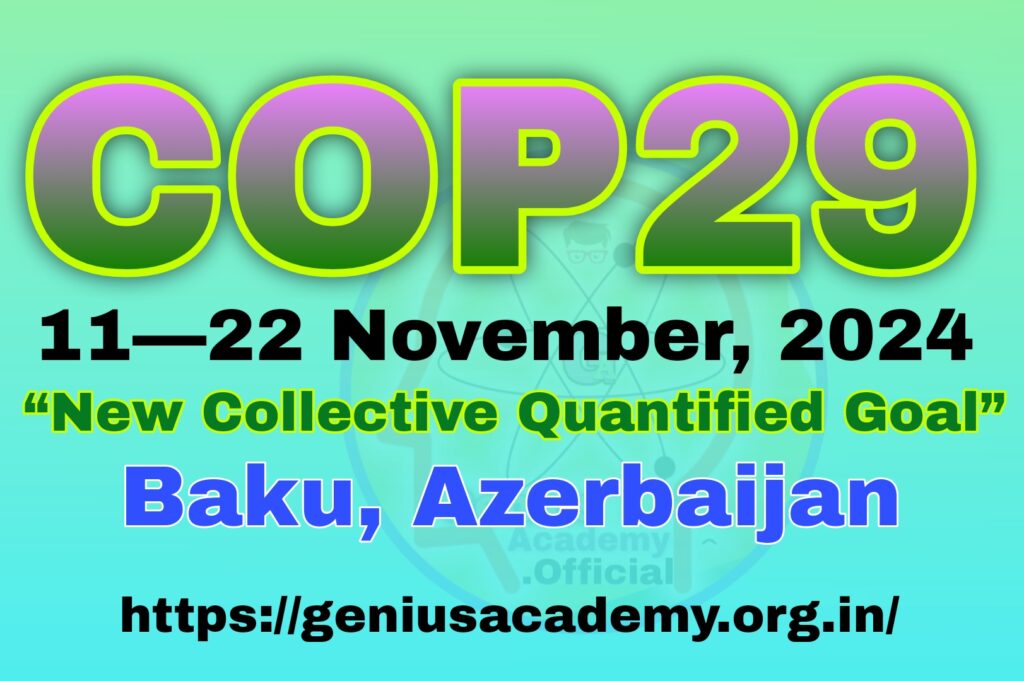Context
The upcoming COP29, scheduled to take place in Baku, Azerbaijan, from November 11-22, 2024, will heavily center around the New Collective Quantified Goal (NCQG) for climate finance. This goal will determine the future direction of global climate finance and its role in mitigating climate change impacts, especially for developing countries. COP29, often referred to as the ‘finance COP,’ underscores the need to address the “needs and priorities of developing countries” as mandated by Article 9 of the Paris Agreement, making NCQG a pivotal aspect of the conference.
Unresolved Issues in NCQG Negotiations
1. Structural and Scope-Related Disagreements
- Key Issues:— Countries hold divergent views on the structure and scope of the NCQG, the scale of financial contributions, timelines, and sources of funding.
- Developing Countries’ Position:— These nations emphasize that developed countries should bear the financial burden, given their historical responsibility for emissions. They call for equity in climate finance, with clear, quantitative targets focusing on public finance, grants, and concessional loans, and a defined timeframe (5-10 years).
- Developed Countries’ Stance:— Developed nations advocate for a broader contributor base and emphasize outcome-driven strategies targeting low emissions and climate resilience. They propose more flexible, multilayered financing and innovative funding solutions.
2. Past Financial Pledges and Distrust
- Historical Context:— The $100 billion annual climate finance pledge, established in 2009 and extended to 2025, has been a source of contention. Although this goal was finally met in 2022 (reaching $115.9 billion according to the OECD), its delayed fulfillment undermined trust, leaving developing countries struggling with limited resources.
- Financial Insufficiency:— The pledged amount falls drastically short of what is required. According to the Standing Committee on Finance, climate action costs for 48% of costed needs from 98 countries range from $5.036 trillion to $6.876 trillion.
- Loans vs. Grants:— The over-reliance on loans instead of grants exacerbates debt in vulnerable countries. Effective climate finance must focus on grant-based public finance, supplemented by concessional loans.
Challenges in Climate Finance Access and Distribution
1. Adaptation vs. Mitigation
- Current Bias:— Much of the private sector investment focuses on clean energy mitigation projects, sidelining adaptation efforts, such as infrastructure resilience and disaster management, which have less obvious financial returns.
- Barriers to Accessing Funds:— Developing countries face significant obstacles in accessing funds from international entities like the Green Climate Fund (GCF) and the Global Environment Facility (GEF).
2. Expanding the Contributor Base
- Proposal for Expansion:— Countries like Switzerland and Canada have suggested expanding the NCQG contributor base to include nations with high emissions or high Gross National Income (GNI) per capita, such as China and oil-rich countries like Saudi Arabia and Qatar.
- Equity Concerns:— Developing nations view this as a threat to the principles of equity and “common but differentiated responsibilities.” They fear it could dilute developed countries’ accountability and shift the financial burden unfairly.
Core Principles of NCQG and Article 9 of the Paris Agreement
1. Emphasis on Public and Grant-Based Finance
- Adaptation Priority:— Article 9 of the Paris Agreement emphasizes a balance between adaptation and mitigation finance. Grant-based finance for adaptation must remain central to avoid deepening developing countries’ debt burdens.
2. Developed Countries’ Narrative Shift
- Focus on Low Emissions and Climate Resilience:— Developed countries’ focus on a broader interpretation of climate finance obligations potentially undermines the spirit of the Paris Agreement and risks diluting their legal responsibilities.
- Pacta Sunt Servanda Principle:— This principle, which demands adherence to treaties in good faith, must be upheld to maintain trust in international agreements.
Updated Definition of Climate Finance and Key Issues
1. Operational Definition by the Standing Committee on Finance
- Current Definition:— Climate finance includes reducing emissions, enhancing greenhouse gas sinks, increasing adaptive capacity, and mainstreaming resilience in human and ecological systems. It supports actions in nationally determined contributions (NDCs) and adaptation plans.
- Lack of Additionality Reference:— The absence of a clear reference to “additionality” leaves room for ambiguity in whether climate finance constitutes new and incremental support.
2. Role of Private Investment
- Investment vs. Finance:— While private investment can support clean energy initiatives, it often lacks alignment with broader climate priorities like adaptation. The inclusion of private investments in the NCQG without proper safeguards may weaken accountability for developed countries to provide targeted public finance.
Broader NCQG Considerations
1. Technology Transfer and Capacity Building
- Developing Countries’ Needs:— Climate finance must extend beyond monetary assistance, encompassing technology transfer and capacity building to support both mitigation and adaptation.
- Access Barriers:— Procedural hurdles in multilateral mechanisms often prioritize “value-for-money” over “need-for-money,” complicating access for developing countries.
2. Role of Multilateralism and Trust Building
- Need for Faith Restoration:— Successful negotiations at COP29 hinge on whether the NCQG can restore trust between developed and developing countries and reinforce multilateralism. If it fails to address historical responsibilities and equity, it risks deepening divides.
The Path Forward for NCQG at COP29
The success of the NCQG will depend on its ability to truly address the urgent needs of developing countries, including fair finance, technology transfer, and capacity-building support. As nations convene in Baku for COP29, the world will be watching to see if global leaders can deliver on their promises and commitments. The NCQG must move beyond symbolic pledges to deliver substantive, equitable, and transparent outcomes, ensuring that climate finance effectively combats the climate crisis without burdening those least responsible for its cause.

Zeroing in on Methane Diplomacy: India’s Role at COP29

